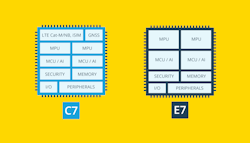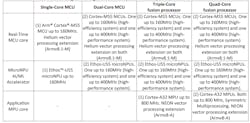Startup Rolls Out Energy-Efficient, AI-Focused Fusion Processors for IoT
Reza Kazerounian has been on the front lines of many of the world’s largest microcontroller companies.
He was general manager of the microcontroller and connectivity business unit at Atmel, now Microchip. Before that, he led the automotive and industrial businesses at Freescale, now NXP Semiconductors, where he was responsible for the connectivity, microcontroller, sensors, and analog product divisions. Before he landed at Freescale, he held management roles at STMicroelectronics, including as CEO of the Americas region of ST.
And he has seen first-hand how the semiconductor industry is preparing for the Internet of Things (IoT) era.
"If you look at the future of intelligent Internet of Things devices, there are many deficiencies” in terms of security, connectivity, hardware acceleration, integration, software reuse, and other areas, Kazerounian said. But the startup he co-founded in 2019, Alif Semiconductor, is trying to fill the gaps and take on the likes of NXP, STMicroelectronics, and TI with a new lineup of energy-efficient, AI-focused embedded processors.
“We want to deliver a new way of developing the embedded systems of the future,” Kazerounian, Alif’s president, said.
Early this month, the company rolled out its first family of processors, Ensemble, that spans from single-core MCUs to quad-core embedded processors ideal for a wide range of IoT devices in tight power envelopes. The chips have artificial intelligence cores baked into hardware. Alif also unveiled its Crescendo family with cellular LTE Cat-M1 and NB-IoT connectivity and support for GPS and other global positioning capabilities.
The Silicon Valley startup, which employs more than 200 people globally, is trying to stand out by designing its embedded processors from a completely clean slate for the IoT market. “Being a startup company affords us the luxury of starting designs from a clean sheet of paper, without being tied to backwards compatibility with dated legacy products, IP, or silicon processes,” Kazerounian said.
With ambitions to become a leading player in the embedded processor arena, the startup has raised more than $70 million in funding to date, largely from WRVI Capital, Kleiner Perkins, and Lightspeed Ventures, according to company filings. The startup's other co-founder is Syed Ali, who served as the president, chairman, and CEO of Cavium before Marvell agreed to buy it for $6 billion in 2018. Ali, the startup’s CEO, also previously worked in leadership roles at Samsung Electronics, where he started the flash memory and CPU businesses.
The Ensemble family spans from single-core Arm Cortex-M55 MCUs to what it calls “fusion processors” that can scale up to dual Cortex-A32 microprocessors (MPUs) to run Linux and other rich embedded operating systems and up to dual Cortex-M55 MCUs that can handle real-time operating systems (RTOS). The Cortex-M55 is a significant step up from the previous Cortex-M series MCUs without pushing the power through the roof (Table 1).
Every Cortex-M55 core, clocked at a maximum of 160 or 400 MHz, is coupled with its own Arm Ethos-U55 NPU that gives the Ensemble family the performance to accelerate AI in the space, memory, and power constraints of IoT devices. The machine learning accelerator clocks in at up to 160 MHz, while the Cortex-A32 runs at maximum clock frequencies of 800 MHz. Alif is also taking advantage of Arm’s Helium vector processing extension in the Cortex-M55 to up the performance of AI workloads.
The chips are supplemented with “large” on-chip SRAM, allowing for larger machine-learning models to fit inside the chip, and flash memory. The chips, which support a single 3.3-V power supply, add special-purpose accelerators for graphics and imaging, a secure enclave, and smart power-management unit (PMU) that shuts down resources on the chip when not in use. Arm said Ensemble is ideal for a wide range of IoT devices, from smart home gadgets, appliances such as refrigerators and washing machines, to industrial systems.
Alif said all the chips are also based on a single “fabric,” including the I/O, peripherals, power management, interrupt handling, and other features, which lowers the bar for the company to expand its product lines with new SKUs. This also gives developers the ability to reuse large swathes of software from device to device, instead of having to start from scratch when they want to build a new product—or upgrade to more advanced Ensemble or Crescendo SKUs with larger pools of memory ormore CPU resources (Figure 1).
This is a “game-changer” for developing IoT devices, Kazerounian said, as it saves time and reduces cost.
“Conversely, [with] embedded controllers that do not begin life from the same well-planned, forward-looking clean sheet of paper, the software that developers must create and use becomes fragmented, incompatible, bloated, and inefficient when they go from one project to the next, with varied levels of functionality,” he said. But with the devices all sharing the same fabric, “the software reuse factor skyrockets in favor of developers.”
Another part of its strategy is keeping up with larger rivals in rolling out Arm’s technologies. According to Alif, starting from scratch “opens the door to use the latest technologies in all aspects of our device families."
Last year, the company became one of the early partners for Arm’s M55 MCU and U55 NPU cores, along with technology and semiconductor giants such as Google, Infineon, NXP, Samsung, and ST, among others.
Many IoT devices are frequently powered by tiny batteries, from wearables strapped to a consumer’s wrist to sensors slapped on factory equipment or slipped inside streetlights or other smart infrastructure. But as companies add more computing power to these devices, the stress on the battery increases.
To address this, the startup developed a unique “autonomous intelligent power management” (aiPM) unit to allow “fine-grained control” of the processor’s resources and when to supply power to them. The aiPM features several independent smart power domains that can automatically shut down different cores when they are not active. In addition, with its internal power conditioning, sequencing, and regulation, the aiPM can take the place of separate power management ICs (PMICs) on the circuit board (PCB), Alif said.
The software-configurable technology works by supplying power only to the portions of the system that are needed at a given time and then shuts them down at all other times. As a result, the aiPM allows even the quad-core fusion processors in the Ensemble and Crescendo families to consume power like small, special-purpose microcontrollers when required, helping extend battery life in consumer robotics or other IoT products.
The startup engineered Ensemble and Crescendo so that the high-efficiency Cortex-M55 MCUs and Ethos-U55 NPUs run at very low power levels while sensing vibrations or sounds in the surroundings, Alif said. the high-efficiency M55 can then wake other portions of the device (such as the high-performance M55 MCUs, A32 CPUs, U55 NPUs, or other processor engines) in an “escalated way” to carry out the workload in front of it.
The power-management system then takes care of shutting them all down when they are no longer needed. In “stop” mode, the chips consume less than 1 uA of power with the real-time clock and wake sources running.
The Crescendo family is based on the same architecture as Ensemble. But it stands out by supporting LTE Cat-M1 and NB-IoT cellular networks, optional integrated SIM for simplified device management, and global positioning systems such as GPS, Galileo, and GLONASS. Furthermore, the GNSS technology can operate at the same time as the cellular IoT modem, which allows customers to avoid time-sharing functionality.
The cellular radio supports a range of global bands and integrates two RF power amplifiers directly on the die, which helps reduce the bill of materials (BOM) and opens the door to smaller, simplified RF modules.
The company is bringing all these building blocks together—memory, power management, RF, positioning, security, and AI—on the same monolithic die that comes as close to a single-chip IoT device as possible. The Ensemble and Crescendo families are based on what Alif called the “latest” silicon-on-insulator (SOI) process technology, with a balance of performance and power savings for IoT gadgets.
Alif said Crescendo delivers the major capabilities required for things such as smart streetlights or other city infrastructure, portable medical devices, drones, security cameras, and wearables—all in a single chip.
Another priority addressed by Ensemble and Crescendo is security. The chips come with advanced on-chip security features with several layers of protections that defend against rogue software attacks, restrict access to secure credentials, delivering another level of security on top of Arm TrustZone.
The chips contain an isolated security subsystem—called a “secure enclave”—that comes with a dedicated CPU and memory, along with immutable secure key storage and cryptography hardware accelerators. The enclave also serves as a root of trust (RoT) to run secure boot, which checks that nothing has been maliciously altered every time the system boots up. The subsystem also powers features, such as device integrity protection and secure identity.
The sum of these features also allows for secure life-cycle management of end products. Customers can choose to use a subset of these features, but once they are installed, they remain active through the entire lifecycle of the product.
Ensemble is now sampling to lead customers in compact wafer-level chip-scale packages (WLCSP) and dual-row quad-flat no-leads (DR-QFN) packages. The Crescendo lineup is also now sampling in WLCSP packages.
The company is starting with 20 to 30 SKUs per product line, but the shared architecture of the chips allows Alif to expand that number rapidly. In addition, Alif’s software, development tools, and kits are now available.
The company said it plans to finish production qualification on the chips in the first quarter of 2022.
About the Author
James Morra
Senior Editor
James Morra is the senior editor for Electronic Design, covering the semiconductor industry and new technology trends, with a focus on power electronics and power management. He also reports on the business behind electrical engineering, including the electronics supply chain. He joined Electronic Design in 2015 and is based in Chicago, Illinois.



